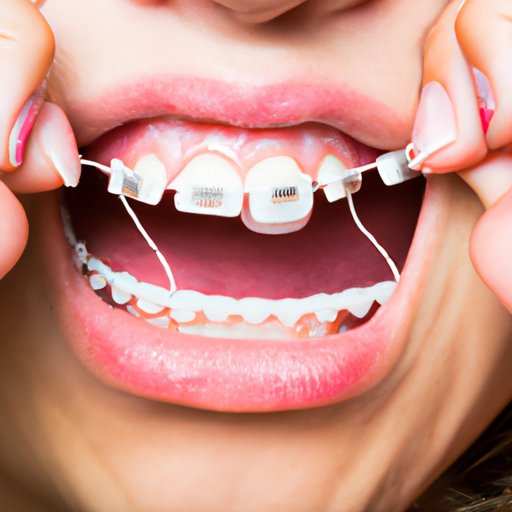
I. Introduction
Having braces can be a challenging experience, especially when it comes to flossing. Braces can make it difficult to properly clean teeth, which can lead to tooth decay and gum disease if left unaddressed. In this article, we will provide a comprehensive guide on how to floss with braces, including step-by-step instructions, videos, tips and tricks, and answers to common questions. By the end of this article, you’ll have all the information you need to keep your teeth and gums healthy while wearing braces.
II. Step-by-step guide: How to floss with braces
Flossing with braces is essential for maintaining good oral hygiene. Food particles and plaque can easily get trapped in between the brackets and wires, which can cause decay and unpleasant odors. Before beginning, it is important to choose the right flossing tool. There are a few types of flossing tools available, such as traditional floss, floss picks, and floss threaders. For braces, we recommend using waxed floss or dental tape as they slide easily between the wires and brackets. Here is the step-by-step guide:
- Cut a piece of floss that is about 18 inches long.
- Thread the floss under the wire and bring it up between two teeth.
- Wrap the floss around one tooth and gently move it up and down.
- Wrap the floss around the other tooth and repeat the up-and-down motion.
- Repeat this process for each tooth.
Flossing should be done at least once a day, preferably before bedtime. It is important to take your time and be gentle, as vigorous flossing can damage the wires and brackets. If you are finding it hard to reach certain areas, you can use a floss threader or interdental brush to help you get in between those tight spaces.
III. Video tutorial: How to floss with braces
For those who prefer visual instructions, we have included a helpful video tutorial. The video will demonstrate the proper technique for flossing with braces, and provide some additional tips for keeping your teeth healthy while wearing braces.
IV. Comparison guide: Flossing tools for people wearing braces
There are a few different flossing tools available for people wearing braces. Some of the most popular options include floss picks, interdental brushes, oral irrigators, and water flossers. Each tool has its own unique benefits and drawbacks, depending on your personal needs and preferences. Here is a comparison guide for flossing tools:
- Floss picks: These are small plastic tools that have a short piece of floss stretched across the top. They are convenient and easy to use, but may not be as effective at removing plaque and food particles as traditional floss.
- Interdental brushes: These are small brushes that are designed to fit in between teeth. They can be helpful for people with braces who have tight spaces between teeth, but may not be as effective at removing plaque as other tools.
- Oral irrigators: These are devices that use a stream of water to clean teeth and massage gums. They can be effective at removing plaque and food particles, but may not be recommended for people with sensitive gums.
- Water flossers: These are devices that use a stream of water to clean teeth and massage gums. They are similar to oral irrigators but may be more effective at removing plaque and food particles.
When selecting a flossing tool, it is important to consider factors such as effectiveness, ease of use, affordability, and personal preferences.
V. Tips and tricks: How to overcome common problems when flossing with braces
Even with the right tools and technique, flossing with braces can be challenging. Here are some tips and tricks from orthodontic professionals, dentists, and people wearing braces:
- Use a floss threader to help you get in between tight spaces.
- Be gentle and take your time – do not force the floss.
- If your gums feel sore or bleed, rinse your mouth with warm salt water.
- If traditional floss is too difficult to use, try an interdental brush or water flosser.
- See your orthodontist or dentist regularly for checkups and cleanings.
VI. Frequently asked questions: Common questions about flossing with braces
Here are some common questions people have about flossing with braces:
- Can you floss with braces wax on?
- Should you floss before or after brushing?
- Do you need to floss both sides of the wires?
- How often should you floss with braces?
- What happens if you don’t floss with braces?
Answers to these questions and more can be found in our frequently asked questions section.
VII. Personal experience: Flossing with braces
Flossing with braces can be a unique experience that varies from person to person. We have asked people who wear braces to share their experiences, tips, and tricks for flossing with braces. Their insights can be found in our personal experience section.
VIII. Conclusion
Flossing with braces is essential for maintaining good oral hygiene. With the right tools and technique, it can be easy and effective. We hope that this comprehensive guide has provided you with all the information you need to keep your teeth and gums healthy while wearing braces. Remember to floss at least once a day, see your orthodontist or dentist regularly, and be gentle with your flossing technique.





